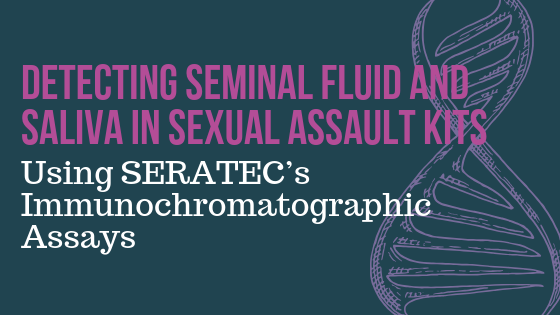This project came to fruition due to discussions I’ve had with case working forensic biologists. Scientists will talk about that vaginal swab they tested during internal validation that they know was negative for semen or saliva, and yet produced a positive result for PSA or amylase. I’ve heard through discussions with other scientists that there is an increase in PSA levels post-female orgasm, yet none of this is recorded in the literature. Then, in 2017, I had a discussion at the NEAFS conference with the folks at Seratec. We began discussing the endogenous levels of PSA and amylase in the vagina and whether or not their tests would detect it. Then and there, over orange juice at breakfast, I said, “Why don’t we find out? Let’s do a study!” and thus began the hunt for 100 female volunteers.
Written by: Jillian Conte, Keystone College
SERATEC® PSA Semiquant is a rapid test for detection of human seminal fluid. This immunochromatographic strip test uses two monoclonal antibodies specific for human PSA and takes place in a compact test cartridge1. The test is performed by placing the extracted sample in running buffer into the test well which has a conjugate pad that is used to transport the sample to the test membrane. The sample will dissolve colloidal gold labeled anti-PSA antibodies. These labeled antibodies will bind to PSA if it is present in the sample and be moved across the membrane by bulk fluid flow to the membrane1. Bound antibodies will then bind to antibodies present in the “T” or test line on the membrane and appear as a pink line. An internal positive control exists in this test and it provides a semiquantitative result1.
The SERATEC Amylase Test is a rapid test for detection of human saliva. It is very similar to the PSA Semiquant described above, however it uses anti-amylase antibodies for detection. Both tests are easy to use, and results are obtained after 10 minutes. They are both attractive for use in processing sexual assault kits for seminal fluid and saliva detection.
Both PSA and amylase are found endogenously in the vagina. With this knowledge and a positive result for either immunochromatographic assay, one might question the reliability of the test result. It is for this reason, we have undertaken a large-scale study to determine the rate of positive results from the SERATEC PSA Semiquant and Amylase Tests with vaginal swabs. The vaginal swabs were collected following IRB approval at all institutions. Volunteers were asked to abstain from male ejaculation in the vaginal cavity for 10-14 days, oral-vaginal contact for 7 days, and female orgasm for 2 days. Swabs were self-collected. Samples were extracted, and the extracts were used for running the PSA Semiquant and Amylase tests. Information about spermicide and contraceptive use was collected from volunteers.
We found a 12.5% positive rate of amylase in the vagina and 3.1% positive rate of PSA in the vagina in our population. This suggests that the endogenous levels of amylase and PSA in the vagina are within detectable levels for the SERATEC Amylase and PSA Semiquant Tests.
This work impacts the field greatly, especially in discussions surrounding sexual assault kit (SAK) testing. These tests are rapid and reliable, which can decrease SAK testing time. Although, not confirmatory, it’s important to understand how endogenous levels of PSA and amylase are detected by the test so to interpret results and describe its probative value appropriately to audiences.
My multi-institutional research team will continue collecting donor samples and analyzing results. Our goal is to analyze 100 samples. After this collection, we will be publishing this information as a technical note/memo so to turn this from rumor to peer-reviewed research.
References
1Laux, D. L., Tambasco, A. J., & Benzinger, E. A. (2006). Forensic Detection of Semen II. Comparison of the Abacus Diagnostics OneStep ABAcard p30 Test and the Seratec PSA Semiquant Kit for the Determination of the Presence of Semen in Forensic Cases.
WOULD YOU LIKE TO SEE MORE ARTICLES LIKE THIS? SUBSCRIBE TO THE ISHI BLOG BELOW!
SUBSCRIBE NOW!


